Hickson Compact Group 90 (HCG 90) is a compact group of galaxies located in the constellation Piscis Austrinus (the Southern Fish). The group consists of four galaxies: NGC 7172, NGC 7173, NGC 7174, and NGC 7176. It is also known as the NGC 7176 Group. It lies approximately 100 million light years away and occupies an area of 7.4 arcminutes of the apparent sky.
The galaxies of HCG 90 are gravitationally bound and strongly interacting. NGC 7174, the central spiral galaxy of the group, is heavily distorted and stretched out due to the interaction with the two large elliptical galaxies. The trio of galaxies are in the process of a slow merger and will ultimately become a single larger galaxy. Observations with the Chandra X-ray Observatory have revealed small common envelopes and bridges of diffuse X-ray emission between the three core galaxies.
HCG 90 consists of two spiral galaxies, NGC 7172 and NGC 7174, and two elliptical galaxies, NGC 7173 and NGC 7176. The galaxies NGC 7173, NGC 7174 and NGC 7176 form a trio that appears to be in the process of merging. The three galaxies are contained in an area only 6 arcminutes across and they are embedded in an extended common envelope. The highly distorted spiral galaxy NGC 7174 is being ripped apart by its two elliptical neighbours.
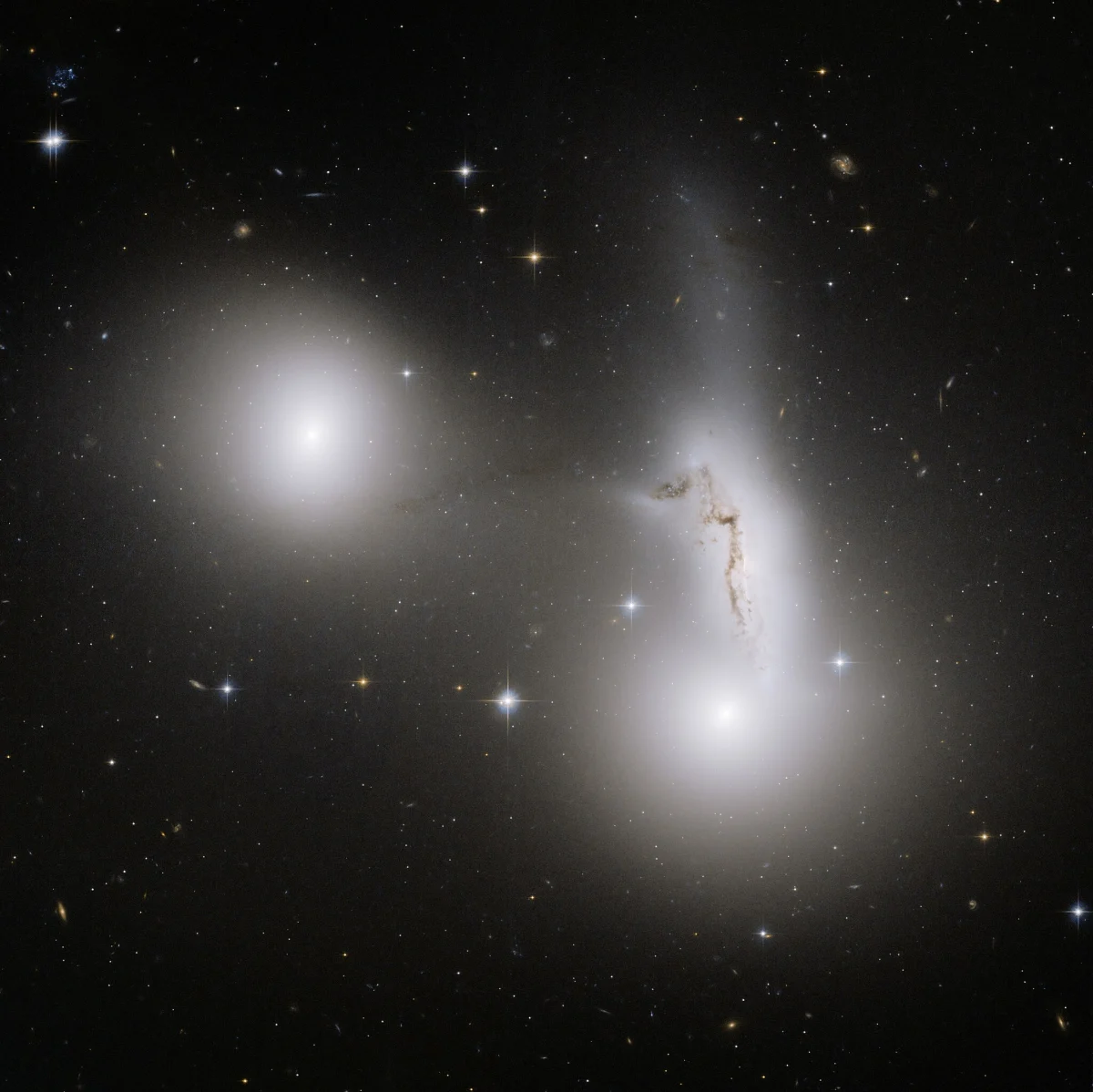
The three pictured galaxies – NGC 7173 (middle left), NCG 7174 (middle right) and NGC 7176 (lower right) – are part of the Hickson Compact Group 90, named after astronomer Paul Hickson, who first catalogued these small clusters of galaxies in the 1980s. NGC 7173 and NGC 7176 appear to be smooth, normal elliptical galaxies without much gas and dust. In stark contrast, NGC 7174 is a mangled spiral galaxy, barely clinging to independent existence as it is ripped apart by its close neighbours. The strong tidal interaction surging through the galaxies has dragged a significant number of stars away from their home galaxies. These stars are now spread out, forming a tenuous luminous component in the galaxy group. Image credit: NASA, ESA, the Hubble Heritage (STScI/AURA)-ESA/Hubble Collaboration, K. Noll (STScI), and R. Sharples (University of Durham, U.K.) (CC BY 4.0)
All four galaxies of Hickson 90 are classified as peculiar because they have been affected by mutual gravitational forces due to their proximity. The spiral galaxy NGC 7172 appears isolated in the group and relatively undisturbed. The main interaction is happening between NGC 7174 and NGC 7173. As a result, stars and gas have been pulled out of NGC 7174 and appear as luminous tidal tails. The encounter is triggering new bursts of star formation in the galaxies, which contributes to the luminosity of the group.
The interaction between the galaxies has produced a significant luminous diffuse light component which contributes between 38% and 48% of the total light in the group. The tidal debris produced by the collision appears unusually bright.
The galaxies of HCG 90 form the core of a loose group that includes 19 other galaxies that show a similar redshift. The brighter ones include NGC 7154, NGC 7163, NGC 7187, and IC 5156.
The galaxy group Hickson 90 was discovered by the British astronomer John Herschel in September 1834. The Canadian astronomer Paul Hickson, Department of Geophysics and Astronomy, University of British Columbia, listed the group as HCG 90 in his small catalogue of compact groups of galaxies published in The Astrophysical Journal in 1982.
The compact galaxy groups included on Hickson’s list were identified on prints obtained in the Palomar Observatory Sky Survey. The best-known ones include Stephan’s Quintet (HCG 92), in the constellation Pegasus, Copeland’s Septet (HCG 57) in Leo, and Seyfert’s Sextet (HCG 79) in Serpens.
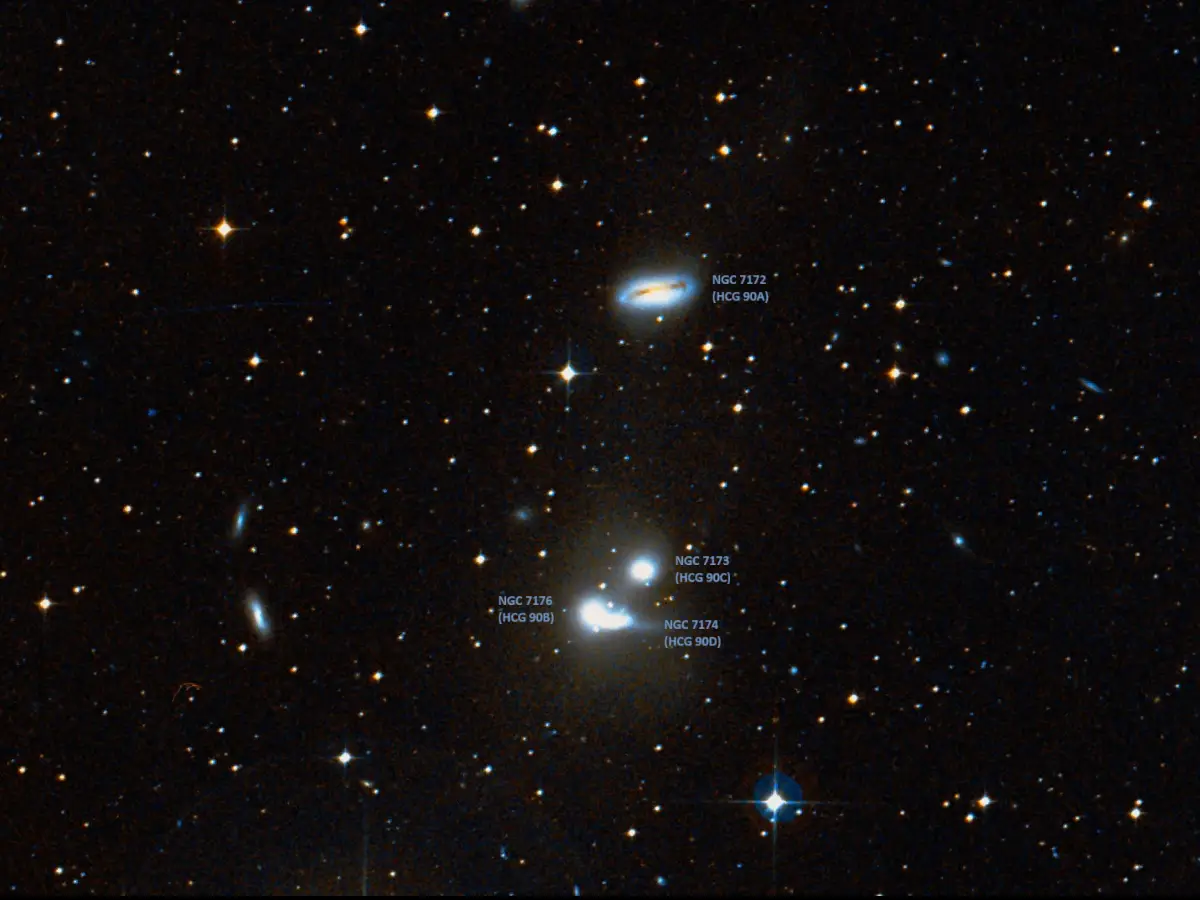
The galaxies in HCG 90, image credit: ESO/Digitized Sky Survey 2 (CC BY 4.0)
NGC 7172
NGC 7172 (HCG 90a) is a spiral galaxy located 110 million light-years away. It appears 6 arcminutes north of the centre of HCG 90, a bit further away from the other three galaxies.
The galaxy appears edge on and has a broad, patchy dark dust lane that obscures its central region. It has an apparent visual magnitude of 11.9 and an apparent size of 2.5 by 1.4 arcminutes.
NGC 7172 has an active galactic nucleus (AGN) and is classified as a Seyfert galaxy. Some sources list it as a Seyfert type 1 galaxy, while others classify it as Seyfert 2. The galaxy’s central supermassive black hole has an estimated mass of 5.5 ×107 M☉ (solar masses).
The galaxy shows evidence of interaction with its neighbours. It is tidally distorted and has a tail of stars and gas extending towards the northwest. The galaxy’s nucleus is a strong infrared source and also emits X-rays.
NGC 7172 was discovered by the British astronomer John Herschel from South Africa on September 23, 1834.
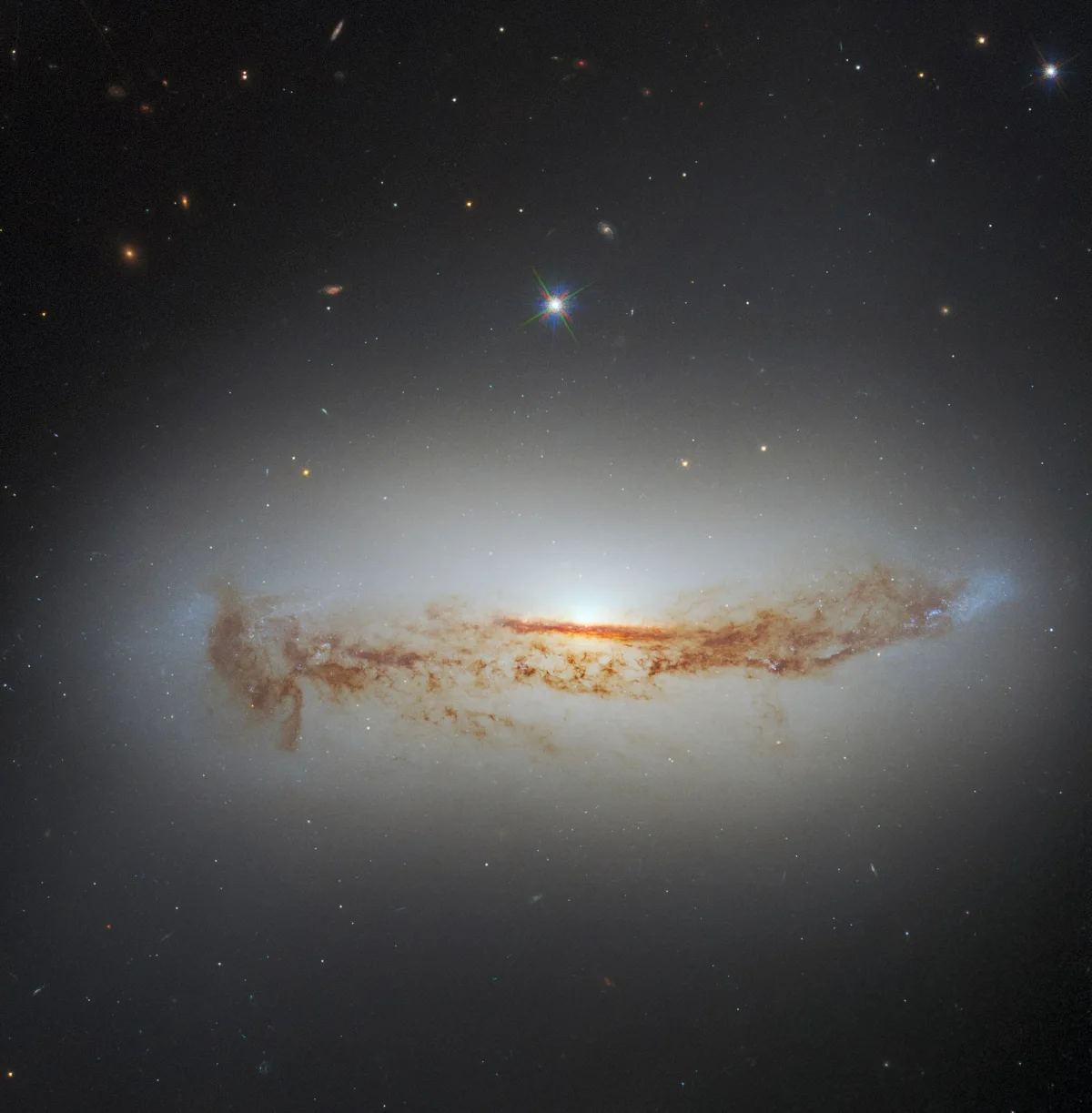
Tendrils of dark dust can be seen threading across the heart of the spiral galaxy NGC 7172 in this image from the NASA/ESA Hubble Space Telescope. The galaxy lies approximately 110 million light-years from Earth in the constellation Piscis Austrinus. The lane of dust threading its way across NGC 7172 — which is viewed side-on in this image — is obscuring the luminous heart of the galaxy, making NGC 7172 appear to be nothing more than a normal edge-on spiral galaxy. When astronomers inspected NGC 7172 across the electromagnetic spectrum they quickly discovered that there was more to it than meets the eye: NGC 7172 is a Seyfert galaxy — a type of galaxy with an intensely luminous active galactic nucleus powered by matter accreting onto a supermassive black hole. This image combines data from two sets of Hubble observations, both of which were proposed to study nearby active galactic nuclei. The image also combines data from two instruments — Hubble’s Advanced Camera for Surveys (ACS) and Wide Field Camera 3 (WFCS). Image credit: ESA/Hubble & NASA, D. J. Rosario, A. Barth; Acknowledgement: L. Shatz (CC BY 4.0)
NGC 7176
NGC 7176 (HCG 90b) is an elliptical galaxy with an apparent magnitude of 12.34. It is the northeastern of the three galaxies that appear close together in HCG 90. It has an angular size of 1.533 by 0.951 arcminutes and is physically much smaller than NGC 7172. John Herschel discovered the galaxy on the same day as NGC 7172.
In 2014, images obtained by the Advanced Camera for Surveys (ACS) aboard the Hubble Space Telescope (HST) helped astronomers identify star clusters in the interacting pair NGC 7176 and NGC 7174. An international team led by J. A. Miah, Department of Physics, Durham University, UK, found that most clusters show colours similar to intermediate and old globular clusters with ages of over 1 billion years. The researchers also found a younger population of blue star clusters that may have formed in the burst of star formation triggered by the close encounter between the galaxies.
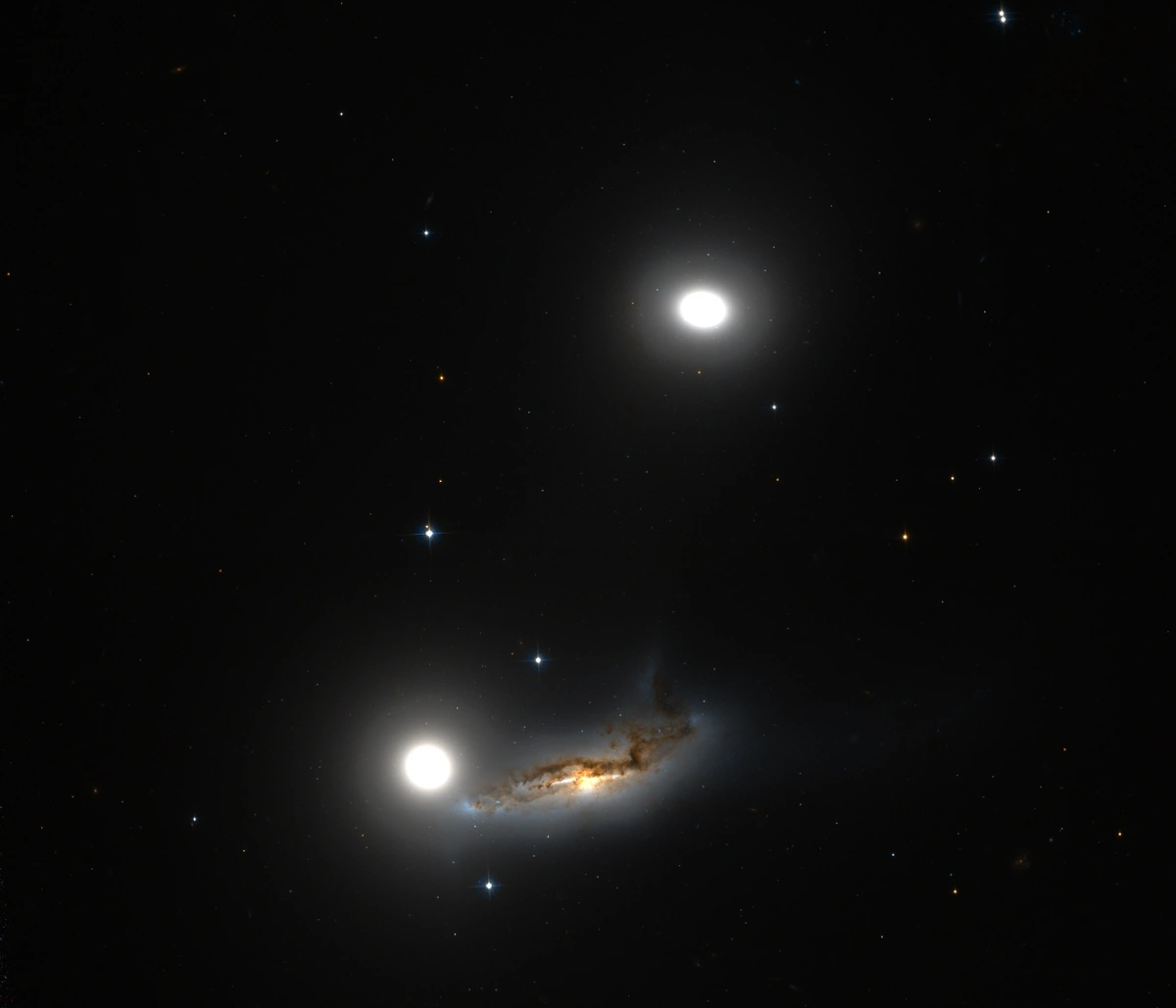
HCG 90 captured by the Hubble Space Telescope, image: NASA/ESA & Hubble (PD)
NGC 7173
NGC 7173 (HCG 90c) is an elliptical galaxy with an apparent magnitude of 13.8 and an apparent size of 0.880 by 0.739 arcminutes. It is the northernmost galaxy in the close triplet. It was discovered by John Herschel on September 25, 1834.
Like NGC 7176, NGC 7173 appears to be a normal elliptical galaxy without much dust and gas. However, the galaxy has a disk of ionized gas that rotates at 60 degrees with respect to the stellar rotation axis. This strongly suggests that the gas has an external origin.
NGC 7174
NGC 7174 (HCG 90d) is a dusty spiral galaxy that appears severely disrupted by the strong tidal interaction with its neighbours. Caught in a tug-of-war between the elliptical galaxies NGC 7173 and NGC 7176, NGC 7174 will eventually be torn apart and its stars and gas pulled out. A faint, broad plume 2 arcminutes across is protruding from the galaxy in the direction of NGC 7173 and another, more diffuse plume is extending to the east.
NGC 7174 has an apparent magnitude of 14.23 and an apparent size of 2.310 by 0.877 arcminutes. John Herschel discovered the galaxy on September 28, 1834.
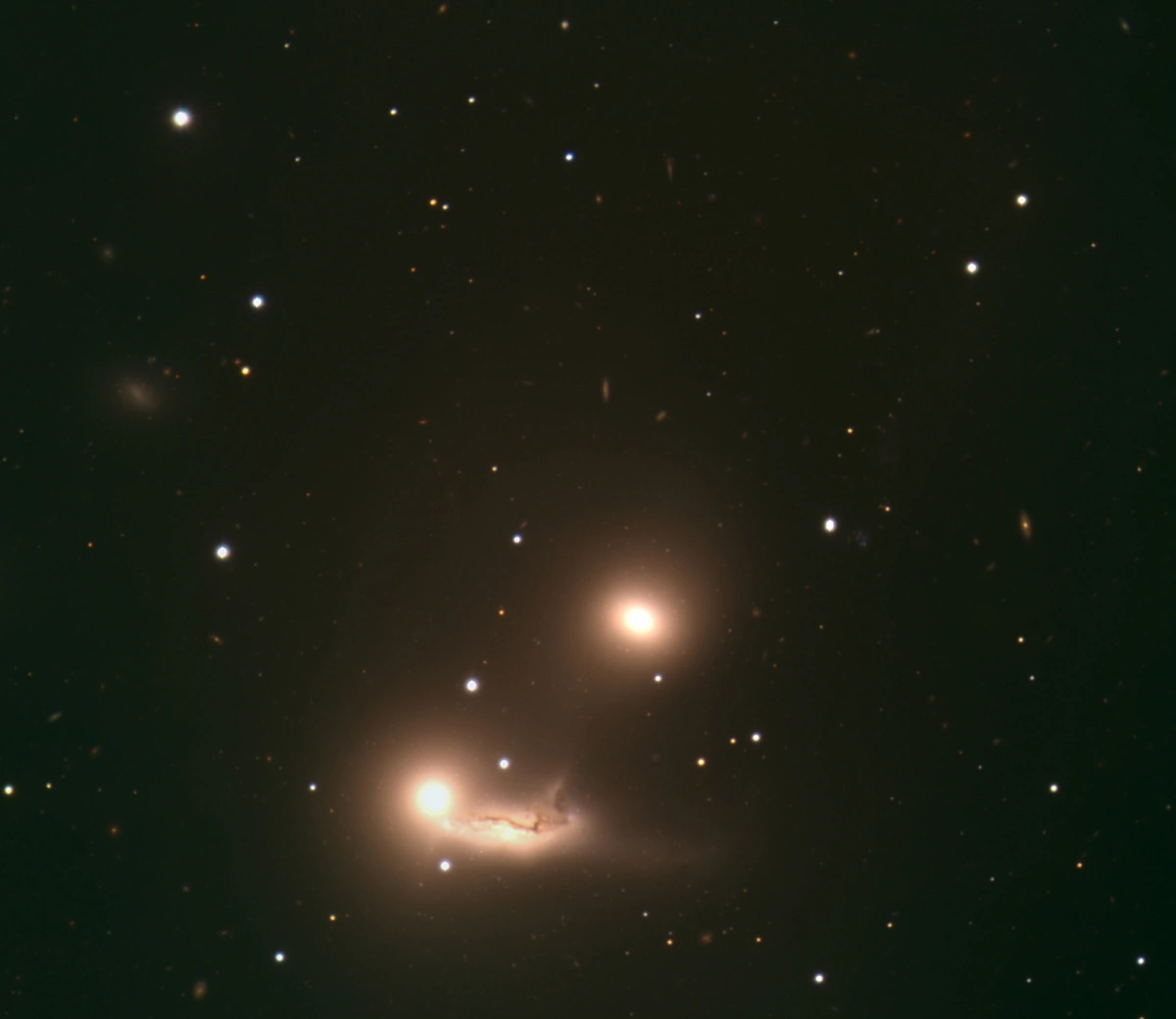
Colour-composite image of the triplet of galaxies, catalogued as NGC 7173 (top), 7174 (bottom right) and 7176 (bottom left), and located 106 million light-years away towards the constellation of Piscis Austrinus (the ‘Southern Fish’). This triplet of galaxies makes up part of the Hickson Compact Group HCG 90. NGC 7173 and 7176 are elliptical galaxies, while NGC 7174 is a spiral galaxy with quite disturbed dust lanes and a long, twisted tail. This seems to indicate that the two lower galaxies – whose combined shape bears some resemblance to that of a sleeping baby – are currently interacting. Astronomers have suggested that the three galaxies will finally merge. The size of the image is about 5.3 arcminutes. The image is based on data obtained with the VLT FORS1 instrument on ESO’s Very Large Telescope through three different filters, B, V, and R. The data were extracted from the ESO Science Archive and fully processed by Henri Boffin (ESO). Image credit: ESO (CC BY 4.0)
Location
The Hickson Compact Group 90 lies in the faint constellation of Piscis Austrinus, west of the bright Fomalhaut and roughly halfway between Alnair, the brightest star in Grus (the Crane) and Deneb Algedi in Capricornus (the Sea Goat). The nearest relatively bright star to HCG 90 is Aldhanab, which used to mark the tail of the Southern Fish before it was assigned to Grus.
Piscis Austrinus lies in a relatively inconspicuous part of the sky south of the celestial equator. Its brightest star, Fomalhaut, can be found by extending a line from Scheat through Markab in the Great Square of Pegasus across the sky. It is the only first magnitude star in the area.
Like most Hickson galaxy groups, HCG 90 is best seen in telescopes with longer focal lengths and it requires exceptionally good observing conditions.
At declination -32°, Hickson 90 is best seen from the southern hemisphere. It never rises above the horizon for observers north of the latitude 57° N.
The best time of the year to observe deep sky objects in Piscis Austrinus is during the month of October, when the constellation appears higher above the horizon in the early evening.
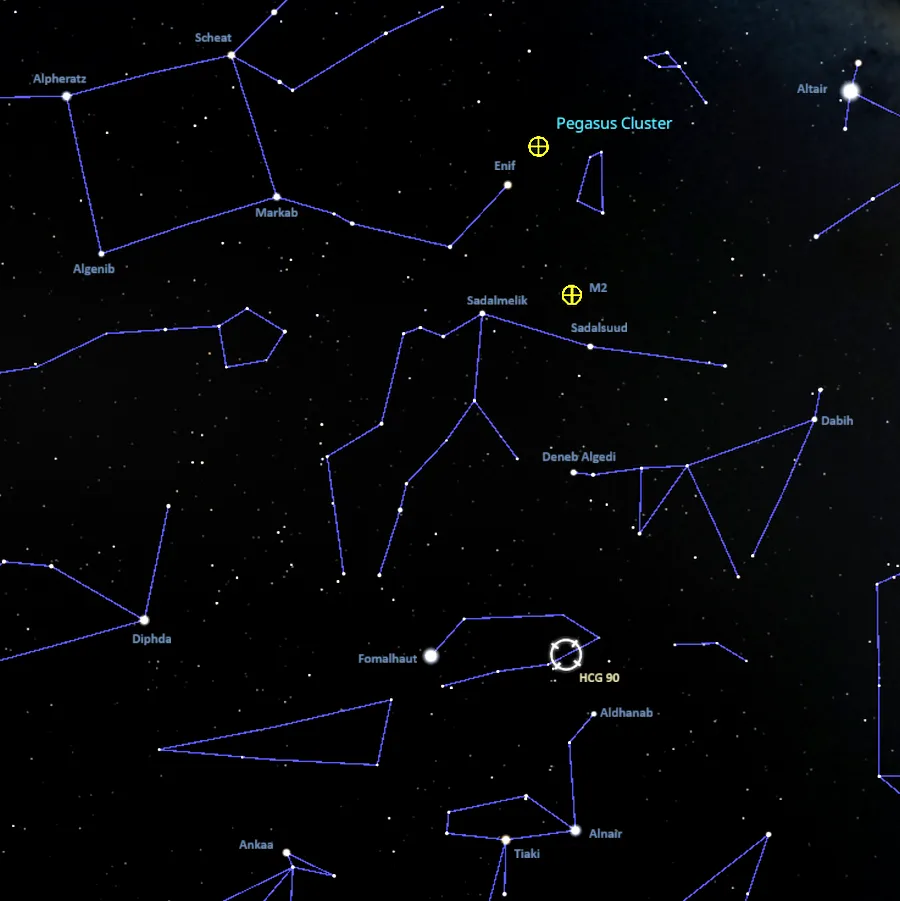
HCG 90 location, image: Stellarium
HCG 90
| Constellation | Piscis Austrinus |
| Object type | Compact galaxy group |
| Right ascension | 22h 02m 06.3s |
| Declination | −31° 55′ 48″ |
| Apparent size | 7.4′ × 7.4′ |
| Names and designations | Hickson Compact Group 90, Hickson 90, HCG 90, Klemola 34, VV 698, NGC 7176 Group, XCLASS 2145, SCG2 2159-3210, BAX 330.5234-31.9668, BAX 330.6308-32.0828 |
NGC 7172
| Object type | Spiral galaxy |
| Morphological type | Sa pec |
| Right ascension | 22h 02m 01.9s |
| Declination | −31° 52′ 11″ |
| Apparent magnitude | 11.9 |
| Apparent size | 2.5′ × 1.4′ |
| Distance | 110 million light years (34 megaparsecs) |
| Redshift | 0.008683 ± 0.000040 |
| Heliocentric radial velocity | 2,603 ± 12 km/s |
| Size | 100,000 light years |
| Names and designations | NGC 7172, HCG 90a, LEDA 67874, PGC 67874, ESO 466-38, ESO 466- G 038, ESO-LV 466-0380, MCG -05-52-007, AM 2159-320, IRAS 21591-3206, IRAS F21591-3206, 2MASX J22020189-3152116, 2MASS J22020187-3152107, MAXI J2202-319, 2MAXI J2201-317, AKARI-IRC-V1 J2202019-315211, GLEAM J220201-315206, ISOSS J22020-3152, SWIFT J2201.9-3152, SWIFT J2201.8-3152, SWIFT J2202.1-3152, CXOCY J220201.9-315210, PBC J2202.0-3152, dCAZ94 HCG 90-01a, SGC 215907-3206.6, dCAZ94 HCG 90-01, 6dFGS gJ220201.9-315211, WISE J220201.89-315210.3, WISEA J220201.89-315210.5, GSC 07489-01499, INTREF 1066, TIC 80055909, NVSS J220201-315210, PSCz Q21591-3206, SRGA J220201.3-315159, SUMSS J220201-315207, 2XMM J220201.8-315210, TGSSADR J220201.7-315214, XSS J22013-3147, [ZM98] HCG 90 2, [SLK2004] 1741, [SLK2000] 106, [CHM2007] HDC 1175 J220201.89-3152116, [CHM2007] LDC 1496 J220201.89-3152116, [DML87] 720, [HB91] 2159-321, [HSN2016] J330.50-31.86, [KRL2007b] 391, [VV2000c] J220201.9-315208, [VV2003c] J220201.9-315208, [VV2006c] J220201.9-315208, [VV2010c] J220201.9-315208, [VV98c] J220201.9-315208 |
NGC 7173
| Object type | Elliptical galaxy |
| Morphological type | E+ pec: |
| Right ascension | 22h 02m 03.1741852512s |
| Declination | −31° 58′ 25.338407412″ |
| Apparent magnitude | 13.8 |
| Apparent size | 0.880′ × 0.739′ |
| Redshift | 0.009034 |
| Heliocentric radial velocity | 2696 ± 24 km/s |
| Names and designations | NGC 7173, HCG 90c, LEDA 67878, PGC 67878, ESO 466-39, ESO-LV 466-0390, MCG -05-52-8, UGCA 422, VV 698, AM 2159-321, 2MASX J22020320-3158253, SGC 215909-3212.9, APMBGC 466-093+113, GSC 07489-01665, dCAZ94 HCG 90-03, dCAZ94 HCG 90-03c, 6dFGS gJ220203.2-315825, [CHM2007] HDC 1175 J220203.20-3158253, [CHM2007] LDC 1496 J220203.20-3158253, [KK2000] 66A, [ZM98] HCG 90 3, [FWB89] Galaxy 445, Gaia DR3 6612938983621292544 |
NGC 7174
| Object type | Spiral galaxy |
| Morphological type | Sab pec sp |
| Right ascension | 22h 02m 06.45s |
| Declination | −31° 59′ 34.7″ |
| Apparent magnitude | 14.23 |
| Apparent size | 2.310′ × 0.877′ |
| Redshift | 0.009310 |
| Heliocentric radial velocity | 2778 ± 29 km/s |
| Names and designations | NGC 7174, HCG 90d, LEDA 67881, PGC 67881, ESO 466-40, ESO-LV 466-0400, MCG -05-52-10, VV 698, AM 2159-321, IRAS 21592-3214, IRAS F21592-3214, ISOSS J22021-3159, dCAZ94 HCG 90-04, dCAZ94 HCG 90-04d, PSCz Q21592-3214, SGC 215912-3214.0, [KK2000] 66B, [SLK2004] 1742, [ZM98] HCG 90 9801 |
NGC 7176
| Object type | Elliptical galaxy |
| Morphological type | E+ pec: |
| Right ascension | 22h 02m 08.4333223632s |
| Declination | −31° 59′ 23.446700592″ |
| Apparent magnitude | 12.34 |
| Apparent size | 1.533′ × 0.951′ |
| Redshift | 0.008458 |
| Heliocentric radial velocity | 2525 ± 29 km/s |
| Names and designations | NGC 7176, HCG 90b, LEDA 67883, PGC 67883, ESO 466-41, ESO-LV 466-0410, MCG -5-52-11, UGCA 423, VV 698, APMBGC 466-094+114, dCAZ94 HCG 90-02, dCAZ94 HCG 90-02b, 6dFGS gJ220208.5-315923, GSC 07489-01545, 2MASX J22020846-3159233, SGC 215914-3213.9, [CHM2007] LDC 1496 J220208.46-3159233, [KK2000] 66C, [FWB89] Galaxy 446 |